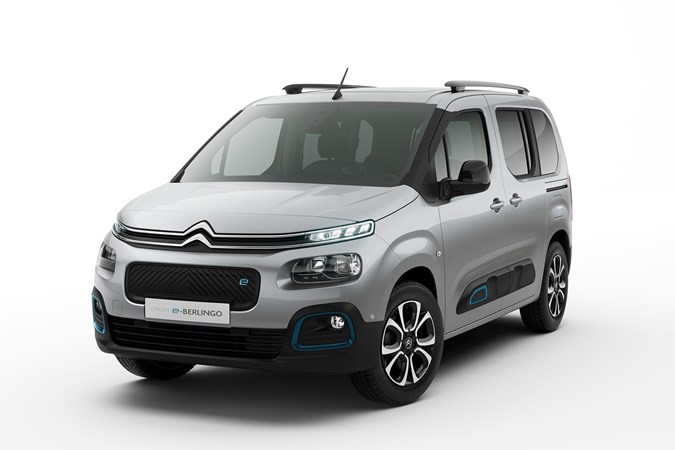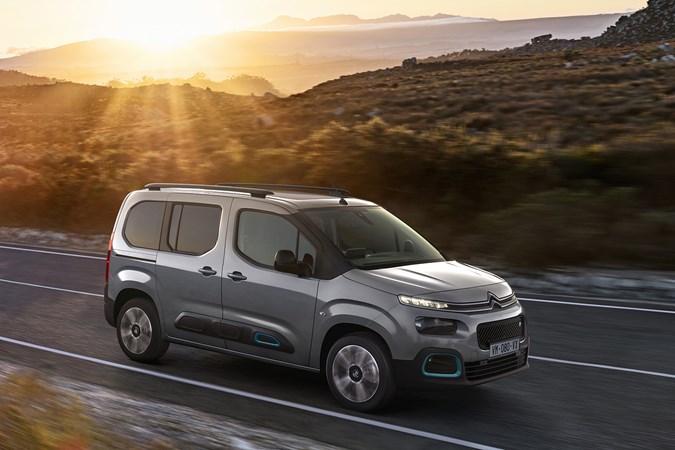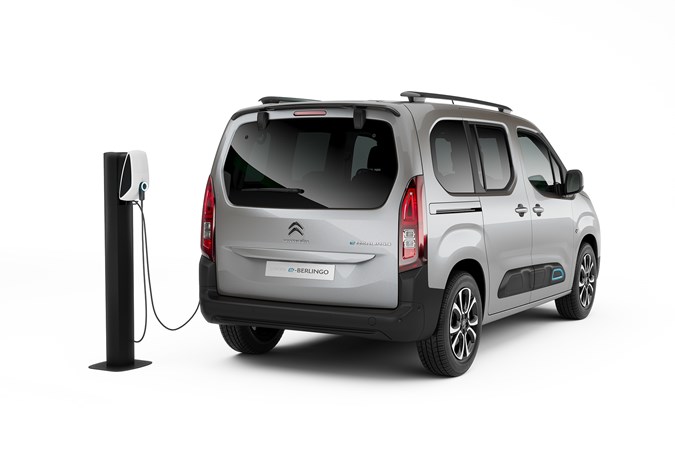Hold the front page, it’s another 50kWh, 136hp electric car from the Peugeot-Citroen half of newly-formed automotive supergroup Stellantis. This one is the Citroen Berlingo; already a very capable, sensible family car it’s now available with zero-emission power.
What’s different about the e-Berlingo?
This is probably the least ‘novel’ car announcement you’re going to read today, because the Citroen Berlingo’s van-derived body is shared with three other MPVs from Vauxhall, Peugeot and Toyota; Vauxhall has already announced the electrified Combo-e Life. Even the electric powertrain is thoroughly proven.
> Revealed: Best new cars to look forward to in 2021
However, the e-Berlingo does have the least-conventional styling, and it also has the benefit of brand recognition. Many of the features these vans are known for, such as the glass roof and clever Modutop storage are innovations from the Berlingo, so it has authenticity and character.
And character goes a long way.

However, unlike its petrol- and diesel-engined versions the e-Berlingo itself does not go a long way. It’s got a 136hp electric motor and is fuelled purely by battery, making it a true electric car. Under the floor is a 50kWh pack which forms the foundation for a lot of EVs from Citroen’s parent manufacturer, including larger vans.
The e-Berlingo doesn’t have the market to itself, though as an electric MPV it is quite a small, yet highly useful niche – the Vauxhall Combo-e Life and Peugeot Rifter versions go on sale simultaneously in the third quarter of 2021. Citroen’s suggested that the e-Berlingo will go on sale in the fourth quarter, but we think it’s more likely that all brands will be available to order at the same time. Five- and seven-seater options will be available in the form of the e-Berlingo ‘Medium’ and e-Berlingo XL.
What is the e-Berlingo’s range between charges?
Under WLTP test conditions the Citroen e-Berlingo achieves a range of 174 miles, which based on our experience with similarly-powered vehicles from Citroen and DS should deliver a real-world range between 130 and 150 miles.
It’s possible to recharge fully in around 30 minutes using a 100kW public rapid charger. Citroen hasn’t released figures for all charging options such as a domestic wallbox, but this consistency of battery and motor means we can look to related cars for a fair estimate. The DS 3 Crossback E-Tense has the same battery pack and takes less than eight hours with the standard 7.4kW on-board charger, so an overnight charge should be possible for most owners with off-street parking. An option for 11kW on-board charging is available if your premises support three-phase power, bringing the full charge time down to five hours.
The charge port replaces the fuel filler, towards the back of the e-Berlingo so you can reverse into spaces and don’t have to wander around the car if you keep the charging cable in the back. Which given the large number of storage spaces in a Berlingo, shouldn’t prove irksome.
What’s the e-Berlingo’s motor like?
There are no changes to Groupe PSA’s proven electric technology here, so it’s the usual 136hp motor that limits power and changes behaviour depending on which of the three driving modes is selected. The controls are familiar too; the toggle switch for forward/reverse, B button for regeneration, and mode selector are common to nearly all Peugeot, Citroen and Vauxhall electric vehicles and behave in much the same way, normalising the future.
Normal mode provides 210Nm and 109hp; ample for a car of this size because as you’re probably sick of hearing, maximum torque is available right away in an electric vehicle. Switch to Power and you get 136hp and 260Nm – better than most diesel options available in cars of this size. It can reach 62mph in less than 12 seconds but that’s not a flat progression, and the 0-30mph performance in town is usually quite sprightly in Citroen’s electric cars and vans – which we don’t expect to change for the e-Berlingo.

Worried about range? Eco delivers 81hp and 180Nm of torque but it’s also necessary if you want to get within a whisker of that WLTP range.
Recuperation has two levels; coasting is possible by default, but if you hit the B-mode you’ll get a predictable and smooth engine braking effect that recharges the battery. It’s less sophisticated than rivals that try to simulate ‘gears’ or go the other way for one-pedal driving, but it is intuitive and effective as a rule. Again, we don’t expect the e-Berlingo to differ much from related vehicles, so this is almost certainly set to be a comfortable, smooth family van.
What else is different about the Citroen e-Berlingo?
Compared with its electric siblings the Berlingo’s appearance is the deciding factor; compared with the regular Berlingo it really does come down to how it’s powered – there are no humps in the floor for batteries, but similarly there’s no recovery of space freed up by not needing a gear selector – the panel for the gears is given over to the e-Toggle switch instead.
Chances are, the biggest change you’ll notice in daily use is the ability to connect to the e-Berlingo via MyCitroen and pre-heat the cabin before driving when it’s plugged in, thus preserving battery capacity.
There’s an extra menu on the infotainment system, and externally, blue highlights and subtle ‘e’ monograms mark out the electrified Berlingo from fuel-sipping equivalents to complete the transformation to electric power.

What we’ve yet to see – but can comfortably predict – is that the e-Berlingo will ride well. Citroen’s seats and suspension complement each other as part of the ‘advanced comfort’ strategy, and in our experience adding batteries to a vehicle like this generally smooths out the ride and lowers the centre of gravity, so the e-Berlingo should be a very relaxing way to get about.
What this means for you
For anyone looking for a solid, comfortable and practical family workhorse, the Berlingo is hard to beat – and the addition of electric power means that buyers who are rational enough to have chosen a Berlingo in the first place can now weigh up their average daily drives and potentially have an environmentally-friendly option with lower running costs, without having to sacrifice those useful touches that make the Berlingo such a good fit.

While many drivers think of their weekly journeys in terms of how often they refill and equate range to ‘500 miles between fills’, it’s unlikely that you have to fill your Berlingo every day – whereas topping up the e-Berlingo at home after every drive may easily become a routine that ensures a full range for every trip. One of the most logical, sensible vehicles available in the UK now ticks the box for electric motoring too.
Parkers will be among the first to drive the electric Citroen e-Berlingo, so keep this page bookmarked for the latest news and views.
Further reading
>> We look at the best electric SUVs on sale
>> We rate the best seven-seaters on sale
>> Find out how much your car is worth with Parkers
>> Citroen Nemo review and buying guide
For all the latest advice, news and finance deals, sign up to the Parkers newsletter here.

Just so you know, we may receive a commission or other compensation from the links on this website - read why you should trust us.







